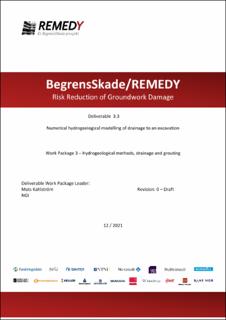| dc.contributor.author | Ånes, Eivind Wiik | |
| dc.contributor.author | Kahlström, Mats | |
| dc.contributor.author | Langford, Jenny | |
| dc.contributor.author | Tuttle, Kevin | |
| dc.coverage.spatial | Norway | en_US |
| dc.date.accessioned | 2024-01-07T15:22:17Z | |
| dc.date.available | 2024-01-07T15:22:17Z | |
| dc.date.issued | 2021-12 | |
| dc.identifier.uri | https://hdl.handle.net/11250/3110273 | |
| dc.description.abstract | The report regards the conceptual and numerical modelling of drainage scenarios to a planned excavation in a deep clay deposit in Oslo, Norway. The modelling was performed in SEEP/W 2D. Ground investigations indicate that the clay lies directly on top of the bedrock, without a layer of moraine between them. The upper metres of the bedrock is assumed to be weathered and serve as a draining layer. The drainage of groundwater to the excavation along steel core piles, and the mitigating effect of cut-off walls of various lengths, were modelled. There were made several versions of the numerical model, with a variation of conductivity and upstream boundary conditions. The simulation results were compared with empirical pore pressure data presented by the R&D project BegrensSkade I (2012-2015). The simulation results deviated notably from the empirical data, leading to the conclusion that the model itself is unreliable. Although there were found weaknesses with the model that could have been improved and resulted in better compliance, some major uncertainties are considered to remain and to affect the results to a significant degree. The uncertainties are in particular related to the modelling of the (weathered) bedrock conductivity, i.e. how the groundwater flows horizontally, vertically and across large distances within the bedrock joints. The discussion of these uncertainties is only introductory, and there is first of all a need to study the literature in greater detail to find out whether these issues are as important as argued here, and whether researchers already have studied them sufficiently. If the literature study comes to the conclusion that more research is needed, two modelling tasks are proposed with the aim to get a better understanding of how the groundwater flow could have been modelled more realistically in a continuum two-dimensional model. | en_US |
| dc.description.sponsorship | Norges Forskningsråd
Research Council of Norway | en_US |
| dc.language.iso | eng | en_US |
| dc.publisher | NGI - Norges Geotekniske Institutt | en_US |
| dc.relation.ispartofseries | NGI-rapport;20170774-D3.3 | |
| dc.title | Numerical hydrogeological modelling of drainage to an excavation | en_US |
| dc.type | Research report | en_US |
| dc.source.pagenumber | 42 | en_US |
| dc.relation.project | Norges forskningsråd: 267674 | en_US |
| dc.relation.project | BegrensSkade / REMEDY | en_US |
